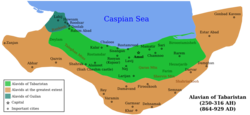
Back علويو طبرستان Arabic Ələvilər (Təbəristan) Azerbaijani علویلر (طبریستان) AZB Alides del Tabaristan, Gilan i Daylam Catalan Dinastiyang Alabida CEB Dinastía alávida Spanish علویان طبرستان Persian Alavides French アラヴィー朝 Japanese Dinasti Alawiyah Malay
Alid dynasties of northern Iran | |||||||
|---|---|---|---|---|---|---|---|
| 645–928 | |||||||
|
Flag | |||||||
 | |||||||
| Capital | Amol | ||||||
| Capital-in-exile | Sari and Astarabad | ||||||
| Common languages | Arabic, Mazandarani | ||||||
| Religion | Islam | ||||||
| Government | Theocratic aristocracy | ||||||
| Emir | |||||||
• 645-670(first) | Hasan ibn Ali | ||||||
• 927–928 (last) | Hasan ibn Qasim al-Da'i ila'l-Haqq | ||||||
| Historical era | Middle Ages | ||||||
• Established | 645 | ||||||
• Disestablished | 928 | ||||||
| Currency | Dinar (gold coins),Dirham(silver coins),Fals(copper coins) | ||||||
| |||||||
Alid dynasties of northern Iran or Alavids (Persian: علویان طبرستان). In the 9th–10th centuries, the northern Iranian regions of Tabaristan, Daylam and Gilan, sandwiched between the Caspian Sea and the Alborz range, came under the rule of a number of Arab Alid dynasties, espousing the Zaydi branch of Shia Islam.
The first and most powerful Zaydi emirate was established in Tabaristan in 864 and lasted until 928. It was interrupted by Samanid occupation in 900, but restored in 914 by another Alid branch.
The second period of the Alid emirate was plagued by internal dissensions and power struggles between the two branches, and ended in the second conquest of the region by the Samanids in 928. Subsequently, some of the soldiers and generals of the Alavids joined the Samanids, among them Mardavij, founder of the Ziyarid dynasty, and the three sons of Buya (Ali, Hassan and Ahmad), founders of the Buyid dynasty.
Local Zaydi rulers survived in Daylam and Gilan until the 16th century.
© MMXXIII Rich X Search. We shall prevail. All rights reserved. Rich X Search
